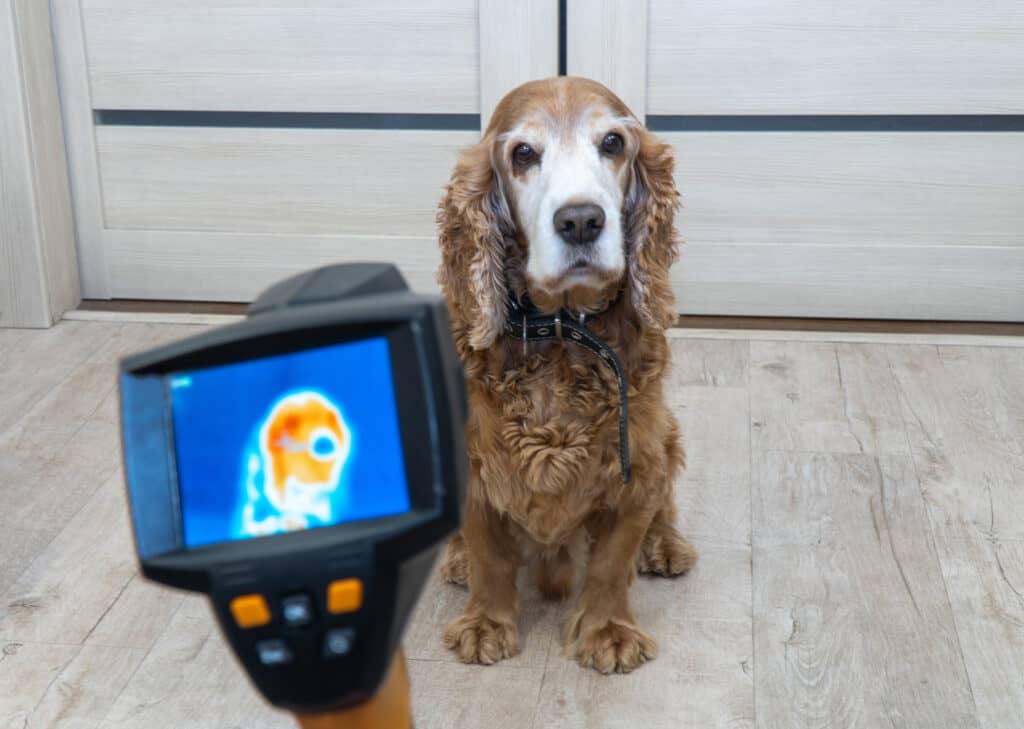Dogs are known for their impressive ability to scope out the world around them with their powerful scent receptors. Dogs have a keen sense of smell that captures even the most undetected of aromas, so many wonder if their vision is just as powerful.
Due to the fact that dogs can smell scents that humans could never detect, this raises the question if dogs can also see things that humans cannot see. One of the most common curiosities is whether or not dogs can see infrared, as this is a common light wave that is just outside of a human’s vision capabilities.
So can dogs see infrared light? The answer may surprise you, so let’s discuss it in detail below!
What Is Infrared?
Before we discuss a dog’s infrared sensing abilities, we should first breakdown the details of infrared waves themselves. Infrared light wave technology exists everywhere in the world around us, ranging from the remotes we use to control our TV’s to the toaster ovens we use to prepare our breakfasts. Everything in the world emits some form of infrared radiation, and we have simply learned how to channel this natural occurrence and use it to our benefit.
This natural occurrence was discovered in the 1800’s when an astronomer named William Herschel learned that each color in the visible spectrum emits a different amount of heat. By placing thermometers next to each different color on the spectrum, he first noticed that there was an increase in temperature when you moved from blue to red. He then realized that there was a higher temperature reading just past the visible red shade on the spectrum, which meant there was heat being emitted by an unseen color. This is how infrared light was discovered!
Now infrared light waves are used for a variety of devices that transport heat from one object to another. This includes everything from hair dryers to laser pointers, so it’s safe to say that we come in contact with a variety of infrared light waves each day. We cannot see these invisible waves with our own eyes, but many wonder if our beloved pets can.

Thermal imaging converts infrared radiation (heat) into visible images.
©iStock.com/Казаков Анатолий Павлович
Do Dogs Have Better Vision Than Humans?
We know that dogs have a better sense of smell than humans do, but does this stand true for their vision capabilities as well? The answer to this question is not straightforward, as dogs view the world in a very different way than you and I do. The structure of a dog’s eye is very different than a human eye, so let’s break down these differences in detail.
Both the canine eye and the human eye rely on their retina to send images to the brain. The retina relays this information by turning light that hits the retina into electrical signals, and these electrical signals are then sent to the brain and converted into images. While the canine retina works similarly to the human retina, dogs have fewer light receptors within the retina. This means that while they can still see the same world we are viewing, they cannot see as many colors as humans can.
On the other hand, while dogs cannot see as much color as you and I can, they do have superior night vision and the ability to track movement. This is due to the fact that dogs have more rod sensitive cells within the retina, and they are responsible for motion visibility and vision in dim light.
So, at the end of the day, dogs cannot see as much color as you and I can, but they do have better vision when it comes to night vision and movement tracking.

While dogs cannot see as much color humans, they do have superior night vision and the ability to track movement.
©iStock.com/Iuliia Zavalishina
Can Dogs See Infrared?
Now that we have a better understanding of infrared waves and a dog’s vision capabilities, we can finally answer the question of whether or not dogs can see infrared. Due to the fact that dogs have a limited ability to differentiate color, they are also unable to see infrared waves with their eyes alone. Infrared waves occur on a color scale that even the human eye cannot see, so it makes sense that dogs cannot visualize these waves either. It is important to note that while dogs cannot see infrared waves in the word around them, they can likely sense their presence. Let’s break down this interesting concept in detail below.
Can Dogs Sense Infrared Around Them?
Our canine companions may not be able to see infrared waves in the world around them, but a study has shown that they can likely still sense them. This study proved that the surface of a dog’s nose (known as the rhinarium) is filled with nerve endings that are sensitive enough to detect nearby infrared waves. This is due to the fact that infrared waves always put off some form of heat, and the dog’s rhinarium can pick up the subtlest of changes in temperature around them.
The powerful nerves on the surface of a dog’s nose can detect minor shifts in temperature in their environment, which may even cause the dog to gravitate toward objects that emit warmer temperatures. Research is still underway on this subject, but experts believe this may play a role in the hunting capabilities of other species as well.

A dog’s nose is filled with nerve endings that are sensitive enough to detect nearby infrared waves.
©bimka/Shutterstock.com
How Do I Know That My Dog Senses Infrared?
Our dogs cannot tell us what they are seeing and feeling in the environment around them, so it’s up to us to pick up on clues and subtle changes in their behavior when they sense something unknown. Every dog will react differently to the temperature changes that infrared waves cause, so let’s list every possible canine reaction below!
Your dog might be sensing infrared waves around them if they are displaying the following behaviors:
- Staring intently at a certain object or area in the room
- Whining at an unknown object or area in the room
- Appearing nervous or frightened when the heat emitting object is being used
- Sniffing an object intently
- Wagging their tail or appearing interested in a certain object once they have determined it is not a threat
Most dogs will react to infrared waves when a certain heat emitting item is being used, so it is most common to see these behaviors when an object using infrared technology is currently functioning.

Your dog might be sensing infrared waves around them if they stare intently at a certain object or area in the room.
©iStock.com/IRYNA KAZLOVA
Is Infrared Dangerous To Dogs?
If dogs can sense infrared waves in the world around them, does this mean they are hypersensitive to these waves and can be harmed by them in any way? While exposure to excessive amounts of infrared radiation can be harmful to dogs, most dogs will never be in a situation that allows this to happen. The most common way that infrared radiation causes harm is when a person or animal is exposed to a sudden and intense visible light, whether this involves staring directly into the sun or another bright light source. However, both dogs and humans are equipped with the instinct to protect themselves from intense light, as we will often begin to blink or turn our heads away from the light source.
If for some reason the dog is unable to protect themselves from the sudden and powerful light source, then the dog can sustain damage to the eyes. The eyes and the skin are the most susceptible to infrared radiation, so if any damage does occur, it will likely be to the eyes or the skin.
At the end of the day, you will not need to be worried about your dog’s harmful infrared exposure within your home. They may be able to sense the temperature changes these waves cause, but they will not be harmed by these exposures.
Final Thoughts On Dogs Seeing Infrared
Dogs may not be able to see infrared light that occurs in the home around them, but they can certainly pick up on the slight temperature changes that infrared emits. The next time your dog is interested in or responds to an object functioning within your home, just remember that they might be picking up on the thermal changes that you and I cannot feel!
Up Next
The photo featured at the top of this post is © iStock.com/Corey O'Hara
Ready to discover the top 10 cutest dog breeds in the entire world?
How about the fastest dogs, the largest dogs and those that are -- quite frankly -- just the kindest dogs on the planet? Each day, AZ Animals sends out lists just like this to our thousands of email subscribers. And the best part? It's FREE. Join today by entering your email below.
Sources
- Nature Portfolio, Available here: https://www.nature.com/articles/s41598-020-60439-y
- Nasa Science, Available here: https://science.nasa.gov/ems/07_infraredwaves
- The Pets Doc Veterinary Clinic, Available here: https://petsdoc.org/through-the-eyes-of-your-dog
Thank you for reading! Have some feedback for us? Contact the AZ Animals editorial team.







